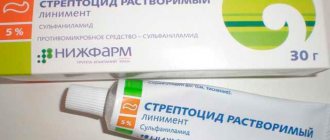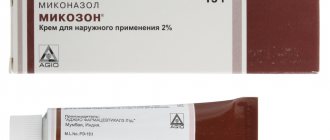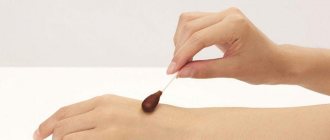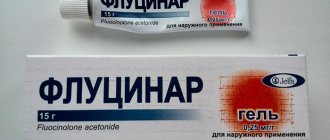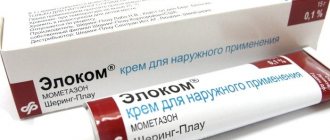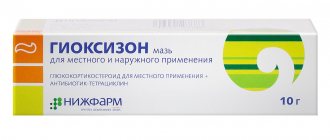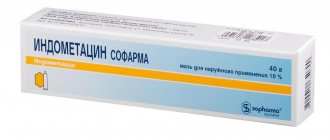Levomekol ointment is needed to treat purulent wounds. It cleanses them of pus, kills germs and helps healing. It is used from the first days, has a long-lasting effect, so a single application to the skin or a gauze bandage is sufficient. Can prevent suppuration in calluses, burns, bedsores.
It is applied to elements of acne, foci of inflammation in the oral cavity, and gynecologists prescribe it for cervical erosion and postpartum perineal ruptures. Urologists recommend Levomekol for men with balanoposthitis. Children are treated for wounds and abrasions, burns after 3 years. It is important not to exceed the duration of use - 5-7 days.
Compound
The main substance of Levomekol is a compound of chloramphenicol and methyluracil. The first of the ingredients has an antibacterial effect on the affected areas, and the second stimulates the process of regeneration and complete healing of injured tissue.
Additionally, Levomekol contains auxiliary agents: polyethylene oxide (PEO-1500 and PEO-400). They are necessary to enhance the action of the main components of the ointment.
The combined effect of the components leads to the antimicrobial, wound-healing and antibacterial effects of the drug. Levomekol is used directly on damaged epidermal tissues.
The drug is available in the form of a white ointment with a thick consistency. The substance is contained in an aluminum tube with a volume of 40 g. In pharmacies, you can purchase bottles of ointment with a volume of 100 and 1000 g on order.
Description
The composition of Levomekol ointment is the same for different manufacturers. The drug contains two active ingredients: 40 mg. methyluracil and 7.5 mg. chloramphenicol in 1 g. medicine.
The ointment base is polyethylene oxide (macrogol). This is a softening and moisturizing agent.
Levomekol is an almost transparent ointment-like substance with a white or yellowish tint. Excipients promote uniform application to the affected area. The ointment is easily absorbed and does not leave a greasy sheen or stains.
Levomekol is produced in Russia and in Ukraine by the Viola pharmaceutical factory. The drug is packaged in aluminum or polyethylene laminate tubes of 30, 40, 50 g.
How it works
Chloramphenicol disrupts protein synthesis in microbial cells and helps destroy pathogenic microflora. Pseudomonas aeruginosa and staphylococcus are sensitive to the component.
Action of the drug:
- antimicrobial;
- local anti-inflammatory;
- removing excess fluid from tissue;
- healing of purulent and necrotic wounds;
- stimulation of regeneration;
- epithelization.
Chloramphenicol acts in infected layers of the skin. At the same time, antibacterial properties are preserved in the presence of pus. The anti-inflammatory effect and regeneration of damaged elements is achieved thanks to methyluracil.
The use of Levomikol eliminates swelling, prevents the development of necrosis, and accelerates wound healing.
The antibiotic chloramphenicol was discovered more than 70 years ago. This bacteriostatic substance does not kill bacteria, but inhibits the growth and reproduction of drug-sensitive microbes. Chloramphenicol has virtually no effect on human or animal cells.
Instructions for use
The ointment is used in surgery, for introduction into the cavity as a healing agent through drainage tubes, as well as for therapy for gynecological problems, in dentistry and for diseases of the upper respiratory tract and nasopharynx.
The product is designed to eliminate pathogenic bacteria and pathogens, both from the skin and mucous membranes. Before using Levomekol ointment, you need to know what organisms it neutralizes.
The drug is effective against:
- rickettsia,
- chlamydia,
- staphylococcus,
- spirochete,
- as well as Escherichia coli and Pseudomonas aeruginosa.
With prolonged use of the ointment, the human body does not have the opportunity to get used to the medicine. Therefore, the drug exerts its effect quite effectively, fighting infections and blocking the formation of purulent exudate.
The presence of purulent content in an open wound does not prevent obtaining a positive result when using the ointment. If the danger of exposure of active components to human internal organs is identified, the drug belongs to the group of low-hazard medications.
During application, in addition to the antimicrobial and antibacterial effects, swelling in the affected area is eliminated. The process is carried out using a dehydrating effect and reducing the size of free intercellular fluid.
Before using this ointment, you need to consider the indications for use. There are situations in which the use of medication is mandatory:
- Burn of an arm, leg or other part of the body of II and III degree;
- Balanoposthitis in men;
- Open wounds with pus;
- Furunculosis;
- Skin diseases with the presence of inflammation;
- Trophic ulcers, bedsores;
- Treatment of sutures after difficult childbirth;
- Sinusitis, sinusitis;
- Inflammation of the middle ear (otitis);
- Skin rashes (acne, rash, urticaria);
- Inflammation of the mucous membrane in the oral cavity;
- Manifestation of hemorrhoids.
In addition, the drug has established itself as a healing ointment for wounds. The product quickly copes with herpes that has developed on the lips or face. It is used to treat skin surfaces, including burns.
Doctors recommend using the ointment as a preventive measure as an ointment for bedsores for bedridden patients or young patients. Levomekol quickly copes with inflamed calluses, especially on the feet, as well as with eczema and cuts. Therefore, in order to start using a medicine in the first stages of the development of a problem or disease, you should know what the drug helps with.
Most often, the medication is prescribed as a therapeutic effect for a course of 14 days. In this case, the active substance is applied to the open wound for 10 hours. If necessary, the ointment layer should be renewed during this time. The effect is carried out only once a day, preferably before going to bed.
An antibiotic is always used only as an external treatment. The surface of the affected area should be treated with hydrogen peroxide before applying the medicine. Only after this the mixture is introduced into the wound cavity or applied on top using a compress. The latter is prepared in the form of sterile gauze and ointment applied to it.
In cases where it is impossible to apply a bandage, levomekol ointment is applied to the wound or crack for 10 days several times a day. If purulent fluid oozes profusely from the affected area, you need to apply a tampon moistened with ointment. This is required so that the consistency loosely fills the damaged surface.
For minor damage to the upper layers of the epidermis, acne, cuts or calluses, the medicine is applied no more than 2-3 times a day.
If there is a need to use the ointment during pregnancy, then the use of Levomekol should be carried out under the supervision of medical personnel or the attending doctor.
This effect is especially important when a significant surface is affected. This is due to the fact that the drug tends to penetrate the systemic bloodstream and is easily transported across the placental barrier, affecting the developing fetus. Any manifestation of a woman’s malaise or poor health is regarded as a threat to the unborn baby. Therefore, during pregnancy you should avoid using the medicine.
Solcoseryl
Available in the form of gel and ointment for external use. The main active component in it is hemodialysate from the blood of calves, which contains the cellular and serum parts of it.
They help improve intracellular respiration and metabolic processes in cells and tissues, accelerate the formation of collagen and fibrinogen, reduce the amount of inflammatory exudate and protect the wound from external aggressive factors.
The gel is used in the treatment of wounds with discharge, swelling, as well as weeping types of inflammation, ulcers, eczema, burns and frostbite. The ointment is used on dry wounds to accelerate their healing and epithelization; it forms a film on the surface of the skin or wound.
Common features with Levomekol:
- Available in ointment form;
- both drugs accelerate wound healing, improve local immunity and metabolism;
- indicated for the treatment of long-term inflammation of the skin and mucous membranes, especially those that are poorly healing.
Differences between drugs:
- wound healing properties are due to the action of different components. For Levomekol - methyluracil, for Solcoseryl - hemodialysate;
- Solcoseryl is produced in 2 forms, of which the gel is applied to wounds with discharge and weeping, and the ointment is applied to dry ones;
- Solcoseryl does not contain antibacterial substances and does not have antimicrobial activity;
- Levomekol, in addition to treating wounds and inflammation, is used in gynecology, proctology, cosmetology, and combustiology.
Side effects
If you do not adhere to the recommendations of your doctor and use the product without observing contraindications and dosage, it is possible to provoke side effects when exposed to the ointment:
- Swelling of the upper soft tissues to which the product was applied;
- Angioedema;
- Hyperemia (redness of the skin in the area affected by the ointment);
- Severe burning and unbearable itching;
- Rashes on the upper layers of the epidermis;
- Hives;
- Atopic dermatitis.
Additionally, the negative effect of the drug may manifest itself as an allergic reaction. It most often manifests itself as a runny nose and severe redness of the skin. Such a manifestation is recorded extremely rarely.
In some cases, ailments are accompanied by general weakness of the patient’s entire body. If any discomfort is detected, you must urgently stop using the medication; the effect of Levomekol ointment will end after 3 days. All symptoms of side effects will completely disappear.
It is strictly prohibited to use Levomekol and other medications for external application at the same time. This is due to the fact that the effectiveness of the active substance in such a situation will be significantly less than expected.
For calluses
In case of formation of calluses on the limbs or other areas, Levomekol is used for treatment. When a bubble forms, the product is applied to the inflamed surface to relieve pain. The consistency is rubbed in slowly with massage movements.
After neutralizing the discomfort, take a sterile needle and carefully puncture the blister in 2 places. This is required so that the liquid inside does not begin to fill with purulent content under the influence of negative factors.
During the puncture, the affected area must be disinfected with a solution of brilliant green (diamond green) or iodine applied. Only after this should you start piercing the papule. When a puncture has formed, a cotton swab is placed on the blister and gradually pressed so that all the liquid comes out without any residue.
After this, the wound is generously lubricated with Levomekol and bandaged. In such a situation, the bandage can be changed after 10 hours. For open calluses, it is recommended to apply the drug every 2-3 hours.
The duration of treatment is determined by the severity of the identified wound. The drug is applied until the damaged area of the skin is completely healed.
For a runny nose, sinusitis, ear inflammation
A common cold, accompanied by a runny nose, can quickly develop into a more serious illness, such as sinusitis or inflammation of the middle ear. In such a situation, you cannot hesitate.
If an inflammatory process with purulent content is detected, which is located on the outside of the hearing organs, the doctor advises applying compresses. The procedure is performed using sterile gauze or a bandage soaked in plenty of medication, twisted into a tight flagellum.
Turunda is installed in the inflamed ear, inserting it shallowly into the ear canal for a period of up to 12 hours. The duration of the treatment process is from 5 to 10 days.
The process is identical when inflammation develops in the maxillary sinuses with purulent content inside. The procedure is also carried out when bacteria are attached to rhinitis. The disease can be identified by the thick green hue of internal secretion, which is poorly secreted and removed from the sinuses. In most cases, the disease provokes an increase in body temperature to 37.5-38 degrees.
For the therapeutic process of preparing the flagellum, it is repeated, as in the case of otitis media, only it is inserted into the nasal sinus. The duration of keeping the medicine in the nose is 4 hours. For minor inflammation, you can apply the product using a cotton swab, thoroughly coating the entire accessible nasal cavity. Improvement occurs within a few days.
How to use it correctly
Before using the ointment, you need to conduct a sensitivity test . Apply it to your child’s elbow or knee area and watch the reaction.
If you have rashes, redness or irritation, do not use the product. If there is no reaction and with the prescription of a specialist, Levomekol can be used.
Do not allow the product to come into contact with the eyes or inside. If the baby accidentally swallows it, it is recommended to do a gastric lavage and give him activated charcoal. In case of contact with eyes, rinse the mucous membranes thoroughly with clean water.
When applying a bandage, secure it tightly so that the child cannot pull it off and inhale the fumes of the drug. Application details depend on the affected area. When applied to the body, a sterile bandage or gauze is used, and when treating the nose, cotton wool is used.
Use of ointment in veterinary medicine
The product is used not only for treating people, but also in veterinary practice. The action of the medicine is necessary to eliminate the purulent content of the wound in case of mixed type infection. Levomekol is used for the treatment of infectious otitis in animals or acute inflammation of the anal glands, which occurs in severe form in dogs.
The drug is used both externally and locally. Patients are given gauze pads soaked in medicine and secured with a bandage. If a purulent process develops, the substance is injected into the cavity using a syringe in which Levomekol is heated to the animal’s body temperature (38-40 degrees).
In case of inflammation on the mucous membrane or skin, the effect is carried out 1-2 times a day.
special instructions
It is better to avoid simultaneous use with drugs that inhibit hematopoiesis.
After using the product, the reactive susceptibility of the skin may increase, which is why hypersensitive reactions may then appear at the time of using the ointment.
If you need to use the ointment for longer than a month, you will need to take a peripheral blood test.
The drug does not in any way affect the ability to drive a vehicle or operate other dangerous machinery.
There are no cases of negative effects when taken in parallel with other drugs.
If the ointment gets on the mucous membranes, you need to rinse them well with water. If the ointment gets inside, you need to rinse the stomach with activated charcoal.
Analogues of Levomekol
If contraindications are identified or side effects are detected, you must immediately contact your doctor to select such medications. There are analogues for replacing Levomekol:
- Levomethyl;
- NoRun;
- Karotolin;
- Fastin 1;
- Levosin;
- Streptonitol;
- Vulnuzan;
- D-Panthenol;
- Lingesin;
- Levomycetin.
Some drugs have an identical composition, others have a similar spectrum of action. Before using any medication, it is recommended that you first undergo an allergic reaction test. Only after the absence of negative symptoms should complex treatment be carried out with a selected analogue.
Can pregnant women be treated?
The period of pregnancy and breastfeeding is not a reason to refuse ointment therapy.
The product does not penetrate the bloodstream and does not harm the child.
For therapeutic purposes, a woman can be treated with Levomekol:
- sinusitis and inflammation of the hearing aid;
- acne on the face and body;
- not extensive burns, abrasions, insect bites.
Obviously, if suspicious symptoms appear, the patient should stop treatment and consult a doctor.
Levomekol or Vishnevsky ointment, which is better?
Determining which is better - Levomekol or Vishnevsky ointment is problematic. These drugs have a different range of effects on the human body.
Vishnevsky ointment is recommended for use in case of trauma or wounding of the skin at the regeneration stage.
The ointment is aimed at disinfecting the affected areas, providing an antiseptic effect. But with such an effect, the medication is not enough to have a bactericidal effect.
In turn, Levomekol, containing an antibiotic, can be used at all stages of inflammation, cleansing and healing of purulent wounds. We recommend the drug for rapid tissue regeneration.
Therefore, Levomekol and Vishnevsky ointment cannot be compared in the treatment of injuries accompanied by inflammation and the formation of pus. These medications are needed in different situations; they are not suitable as a replacement for each other.
Storage
The recommended temperature for storing the ointment is no higher than 25°C. The optimal conditions under which the medicine retains its properties is 18-20°C.
It is prohibited to expose the product to cooling at temperatures below 0°C, heating above 25°C, or exposure to sunlight.
If the storage rules for Levomekol ointment are not followed, the color of the medicine changes and its properties are lost.
The shelf life after opening Levomekol ointment is 4 weeks. The tube is kept at room conditions during use. As for the period after production, it differs from different manufacturers. The Russian pharmaceutical company recommends storing the drug for 3 years, the Ukrainian one - 2 years.
What to choose Ichthyol ointment or Levomekol
Ichthyol ointment is a medicine that has the ability to exert an analgesic effect, keratoplasty, anti-inflammatory and antiseptic effects on the affected area of the body.
The drug regulates the tone of blood capillaries, stimulates a positive effect on the subcutaneous and upper layers of the epidermis in case of inflammation. The ointment is recommended for use in identifying skin problems, the development of arthritis or neuralgic diseases.
Levomekol is used to treat open wounds, but is not very effective for the treatment of inflammation of the internal layers. As a result, medications have different indications for use and do not have the same effect on injured areas with inflammation and purulent formation.
Thus, Levomekol is a drug that has analogues, but cannot be replaced by either Ichthyol ointment or Vishnevsky. Its main effect is revealed in the elimination of inflammation, neutralization of the purulent process and rapid tissue regeneration.
Aekol
Solution for external use. It has a combined composition, which includes vitamin and provitamin A (retinol and beta-carotene), vitamin E (tocopherol), menadione (an analogue of vitamin K).
It has hemostatic, wound healing, anabolic and antioxidant properties. It is used for various skin lesions that heal poorly (purulent wounds, ulcers, burns) with necrotic tissue, as well as in gynecology and proctology.
It has practically no similarities with Levomekol, except for general indications for use in cosmetology, proctology and gynecology.
Differences:
- they have different active ingredients and mechanisms of influence;
- the antibacterial component is found only in Levomekol;
- hemostatic and antioxidant properties - only in Aekol;
- Levomekol is available in the form of an ointment, and Aekol is a solution.
pharmachologic effect
The active ingredients of the drug have a number of positive effects:
- the antimicrobial effect is due to chloramphenicol, which has a detrimental effect on gram-negative and gram-positive pathogenic flora, incl. with pronounced resistance, for example, Staphylococcus spp.;
- the regenerating effect is determined by the methyluracil contained in the ointment, which easily penetrates into the deep layers of tissue, activating the process of formation of new cells and repair of damaged cellular structures. The substance also stimulates cellular metabolism, which also accelerates tissue restoration;
- the immunostimulating effect is associated with the action of methyluracil, which stimulates the production of interferon, has antiviral and a number of other effects;
- the dehydrating effect, closely associated with the regenerating effect, consists in removing excess fluid from the tissues and relieving swelling;
- anti-inflammatory effect is a combined effect that is achieved by the antimicrobial and anti-edematous effect of the ointment.
The drug is classified as a low-hazard substance in terms of its effect on humans.
Pharmacokinetics
After application, it easily and quickly penetrates deep into the tissues. The presence of pus and necrosis does not reduce the degree of penetration of the ointment into the tissue.
Indications, restrictions on medication use
Levomekol has its own indications and limitations for use. When prescribing the drug, the doctor must take them into account. Before carrying out therapy with Levomekol, the doctor must conduct an examination and do the necessary examination. Levomekol is used for surgical pathologies (wounds, complicated course of postoperative wounds). This is the main indication for the drug.
Minor indications for the medicine:
- treatment of bedsores in bedridden patients;
- treatment of hemorrhoids, especially after trauma and the addition of bacterial flora;
- treatment of herpetic skin rashes;
- treatment of acne (pimples, acne);
- therapeutic measures for runny nose and sinusitis, complicated by bacterial pathogenic flora.
- therapy for suppuration of the ear canal and auricle;
- treatment of inflammation of the lymph nodes.
Levomekol is not used for eczematous lesions of the skin. The drug is not prescribed to patients with psoriasis or fungal skin infections. In pediatric practice, Levomekol is used from the age of 3 years. Liniment should not be used if you are allergic to any of the components of the medication. The medication cannot be combined with cytostatic, sulfonamide drugs, or pyrazolone-based drugs. The cost of Levomekol is from 140 rubles.
Treatment of postoperative sutures
The ointment is often used to treat postoperative sutures, including after ruptures in the perineum or episiotomy after childbirth. After hygienic treatment and drying of the suture area, an ointment is applied to sterile gauze and applied to the sutures. Clean underwear is put on upstairs. This bandage is worn for about 6 hours, then removed. Repeat daily.
Treatment of postoperative sutures is carried out in a similar way. What does Levomekol help with in this case? First and foremost, treatment is necessary to prevent infection and promote healing.
